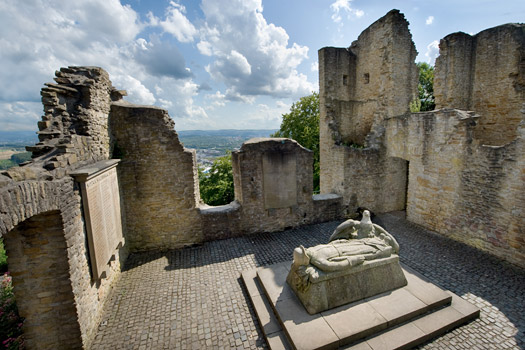
Die Syburg
Karl der Große nahm die strategisch günstig oberhalb des Ruhrtals gelegene sächsische Burg 775 n. Chr. ein. Um 1100 wurde eine Steinburg auf dem Gelände errichtet. Die Befestigung verlor im 14. Jahrhundert an Bedeutung und ist seit dem 17. Jahrhundert zerstört.
© Dietrich Hackenberg
Herrschaft zurück zur Auswahl
With God and Force The Franks conquer the Ruhr Valley
The success of Charlemagne in the conquering Saxony had a two-fold effect: in the mid-term the Franks could conquer the Saxons militarily; in the long-term they could win over the Saxons through Christianity. The strongest weapon of the Carolingians was missionary activity east of the Rhine.
For Charlemagne, Syburg or Sigiburg became the next central hindrance. The Frank Ruler conquered the Saxon Castle strategically located above the Ruhr valley in 775 A.D. A year later, the Saxons attempted in vain to win the castle back. Only at the beginning of the 9th century did they finally end their resistance to the Frank conqueror.
First, Charlemagne, who had been crowned Roman Emperor in Aachen in the year 800 A.D, continually advanced against the Saxons. To this end, he stationed forces in the conquered hill fort Syburg. He not only secured rule over the Hellweg militarily, but also through missionary work. On the mountain plateau, the Franks founded a church and at the river crossing in the flat, they laid the strategically located Reichshof Westhofen. In a later phase, the fortification work on the plateau was minimized. Parts of the wall and moat of this main castle still exist.
In around 1100, a stone castle was built on the land. The fortification lost significance in the 14th century and was destroyed in the 17th century. Parts of the residential building and the donjon have been preserved. In 1930, a war memorial was erected in the ruins to commemorate those who fell in the First World War.
“Hohensyburg” is the popular name for the area within the Saxon Wallburg. In 1857, the Vincke Tower was raised as a memorial for the first governor of the Prussian Province of Westphalia.
In the years to follow, the location began with increasing frequency to be exploited by German nationalistic circles. In 1902, they unveiled the Kaiser Wilhelm Memorial – a testimonial in stone for the effort to combine Carolingian history with the “Empire Unifier” Kaiser Wilhelm I in one context. The National Socialists reduced the number of memorials in 1935 and thereby consciously changed the meaning of what the memorial group was intended to convey. They removed the statues of both sons of Wilhelm I. The emperor was now only surrounded by Bismarck and Moltke. In this way, his role as sole ruler was emphasized and the role of the Hohenzollern was relativized.
Denkmale zum Impuls
Dortmund - Sächsische Wallanlage in Hohensyburg
Um 694 n. Chr. eroberten die Sachsen das ehemalige Bruktererland südlich der Lippe. Ein ... weiter
Dortmund - St. Peter zu Syburg
The success of Charlemagne in conquering Saxony had a two-fold effect: in the mid-term, the ... weiter
Dortmund - Haus Husen
Haus Husen gehört zu einer Reihe von kleinen Adelssitzen, die aus dem karolingischen ... weiter
Dortmund - Burgruine und Vincketurm in Hohensyburg
775 nahm Karl der Große die strategisch günstig auf einem Plateau oberhalb des ... weiter
Dortmund - Kaiserdenkmal in Hohensyburg
Im 19. Jahrhundert bekam das Bergplateau auf dem Syberg, auf dem sich noch heute die Ruinen der ... weiter
